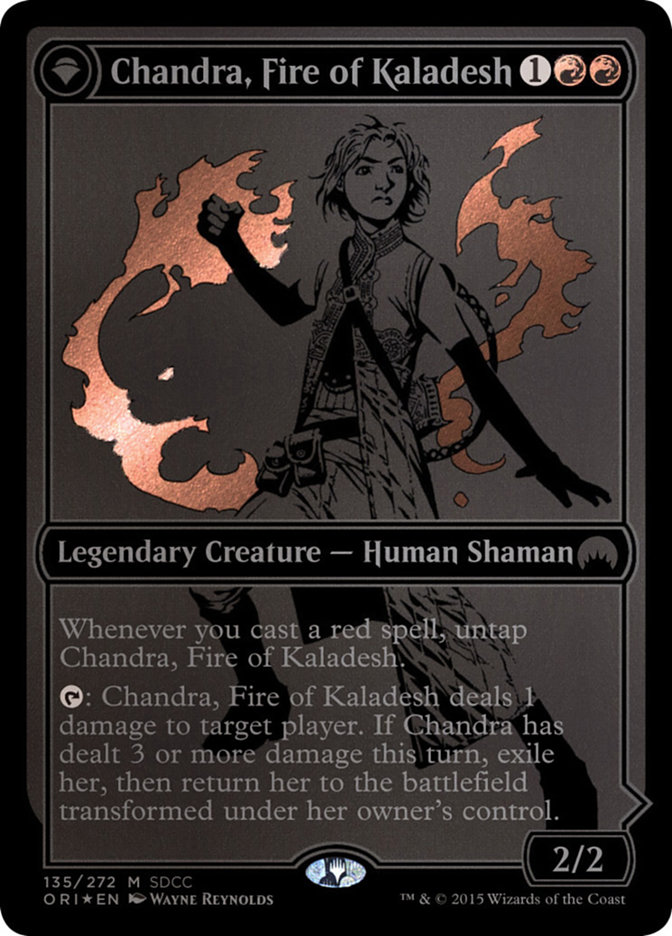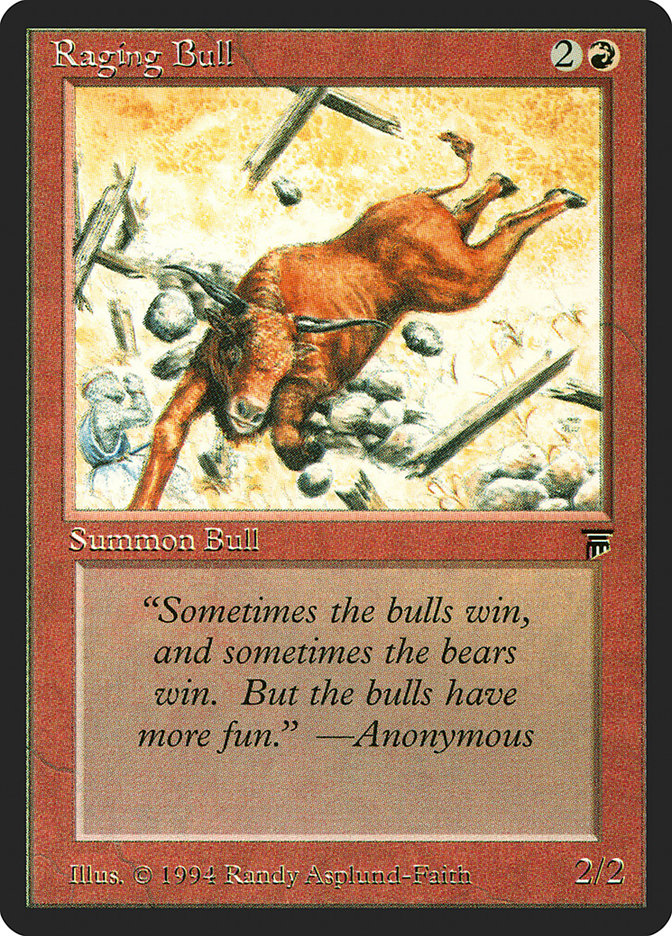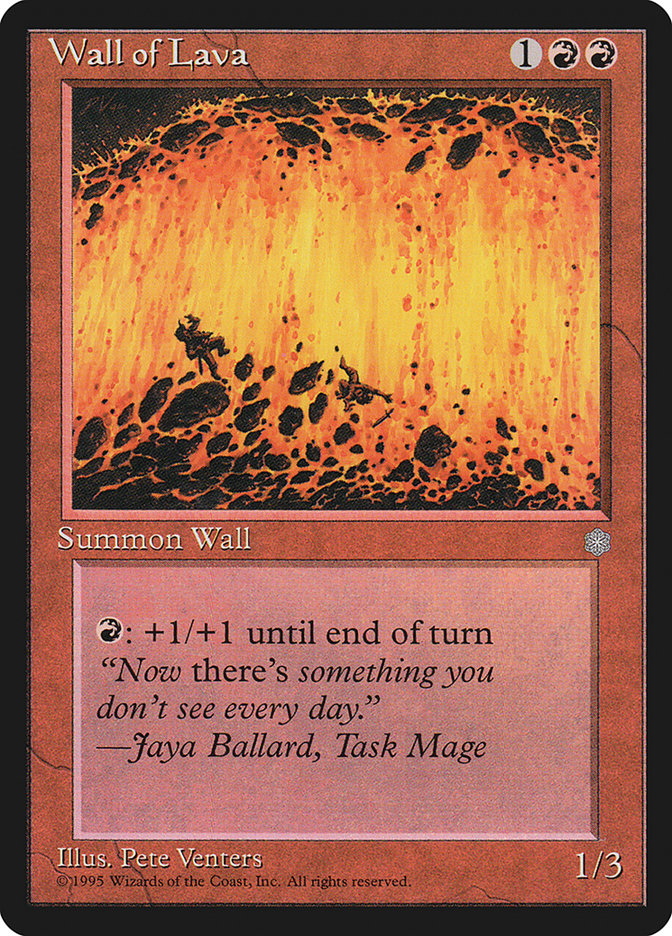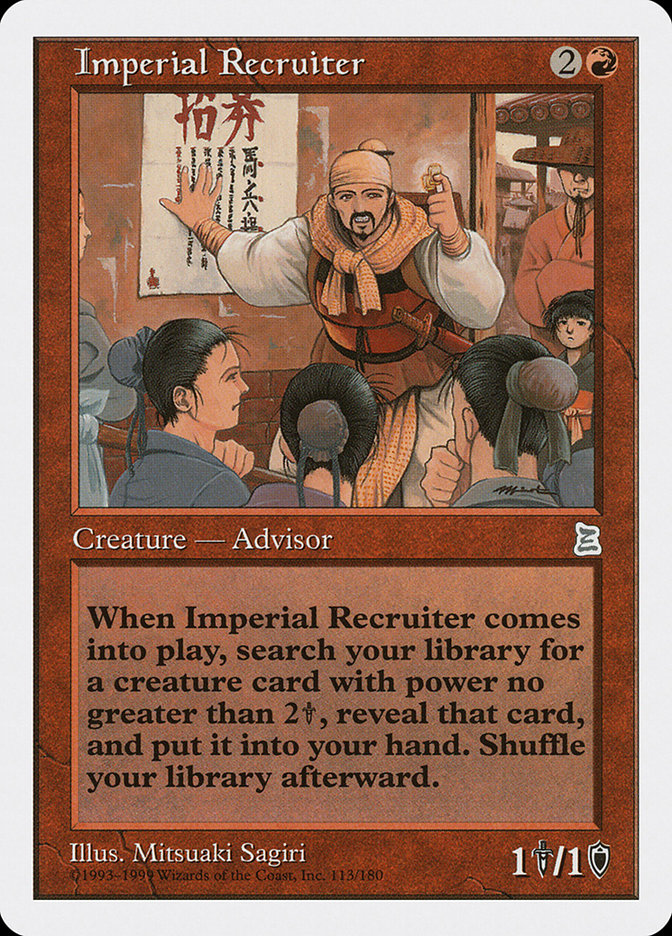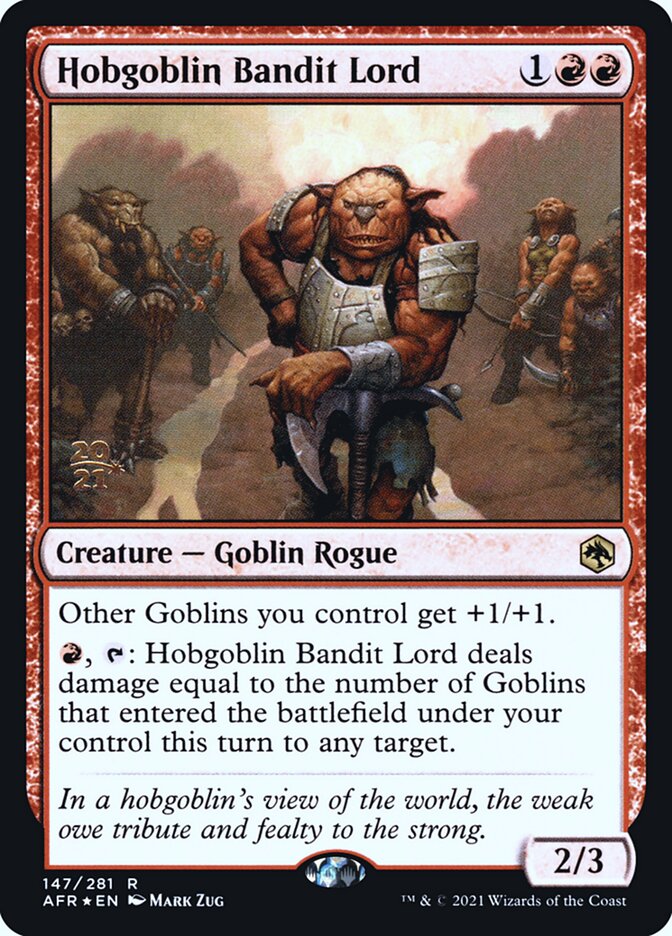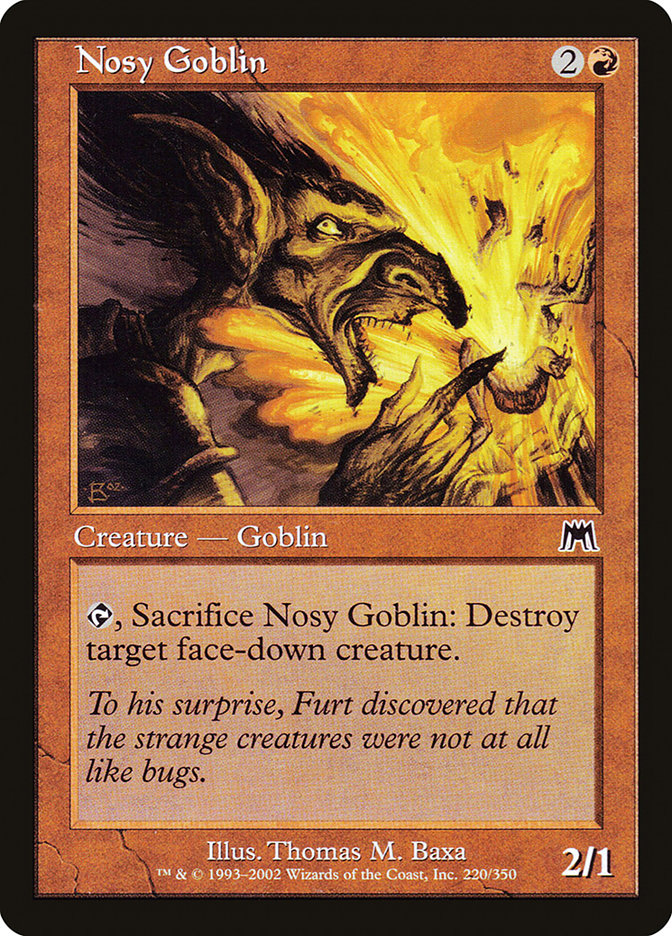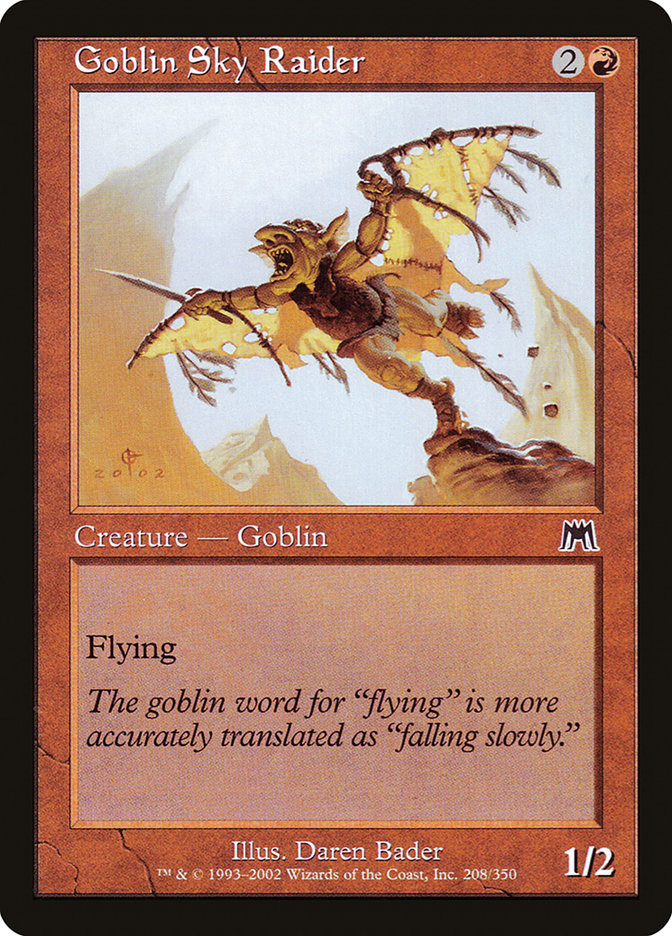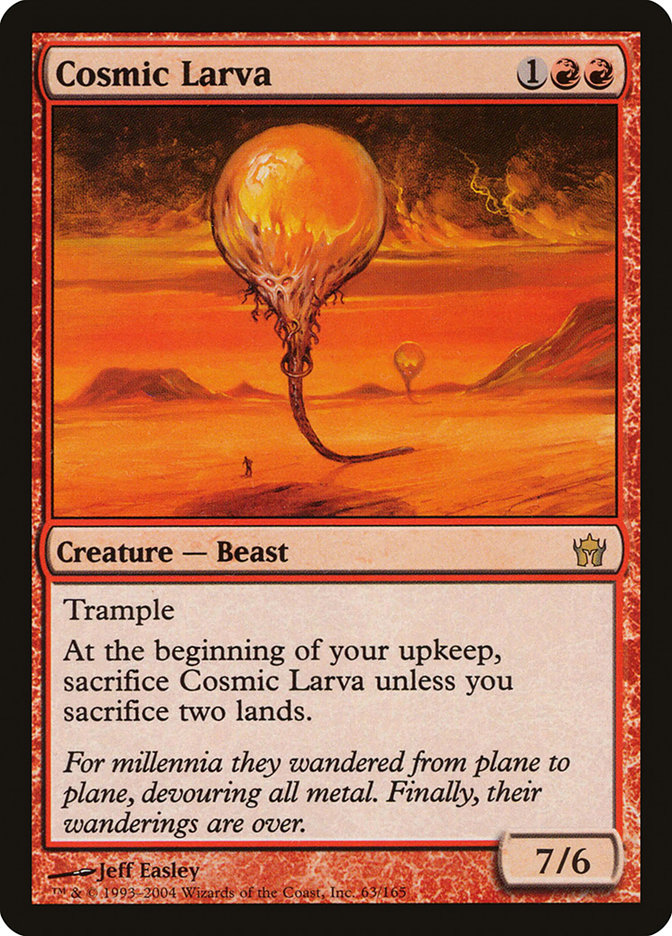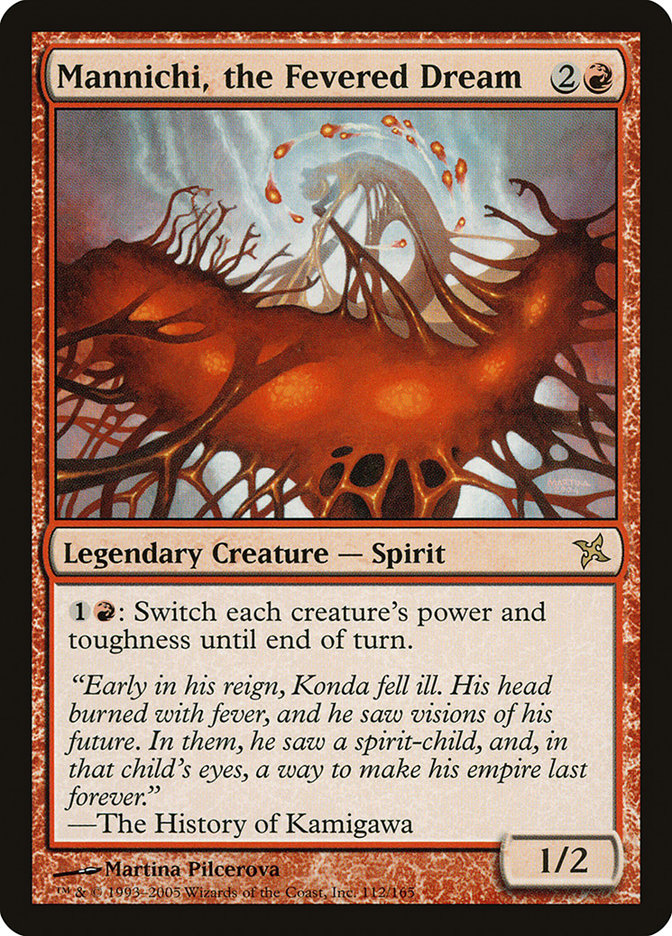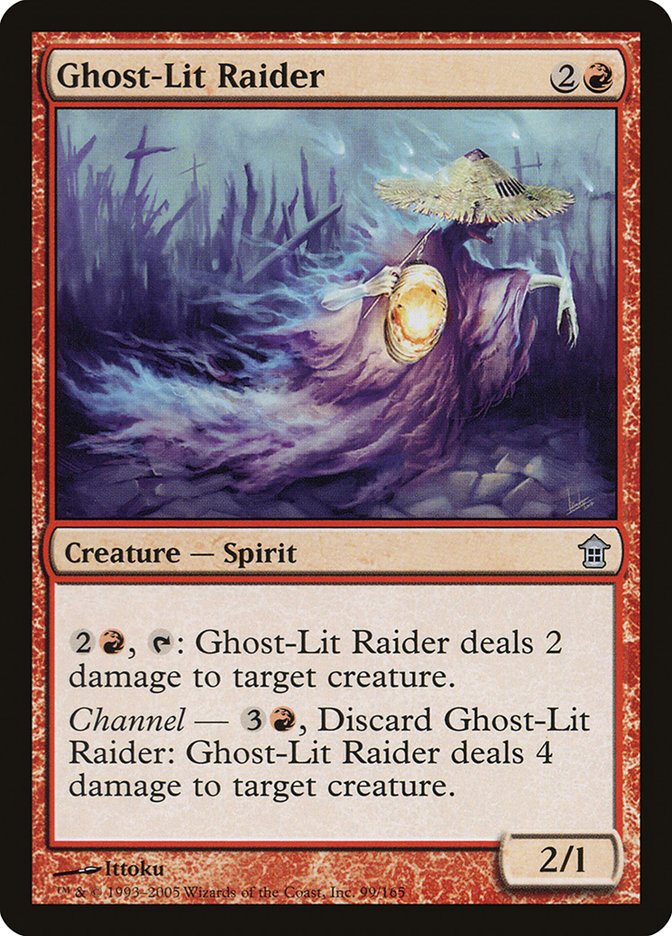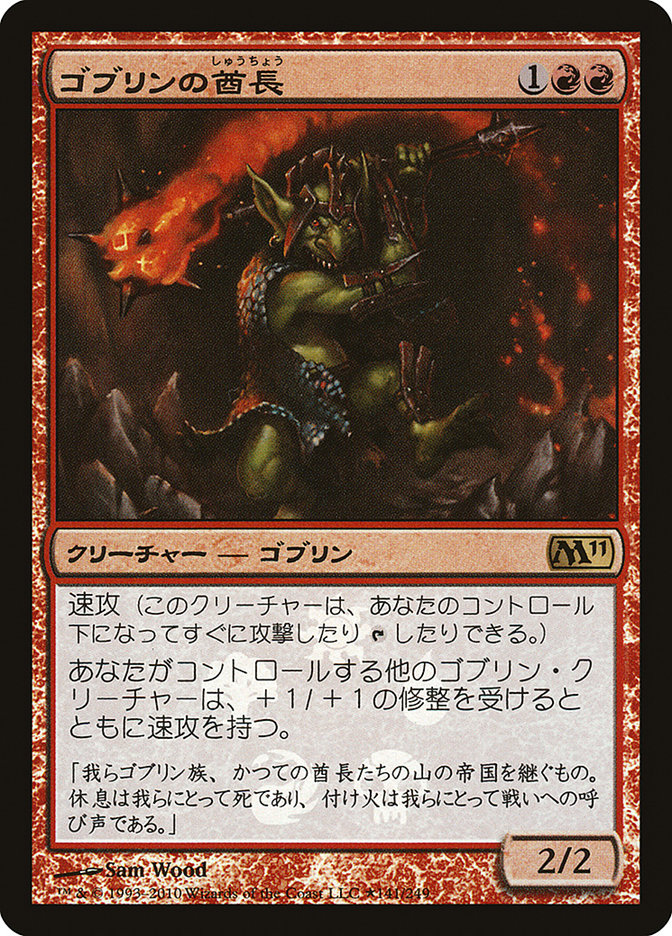Chandra, Fire of Kaladesh // Chandra, Roaring Flame MTG Card
| Card sets | Released in 5 setsSee all |
| Mana cost | |
| Converted mana cost | 3 |
| Rarity | Mythic |
| Type | Legendary Creature — Human Shaman |
| Abilities | Transform |
| Power | 2 |
| Toughness | 2 |
Text of card
Whenever you cast a red spell, untap Chandra, Fire of Kaladesh. : Chandra, Fire of Kaladesh deals 1 damage to target player or planeswalker. If Chandra has dealt 3 or more damage this turn, exile her, then return her to the battlefield transformed under her owner's control.
Cards like Chandra, Fire of Kaladesh // Chandra, Roaring Flame
Chandra, Fire of Kaladesh brings a unique dynamic to the battlefield, standing among other legendary creature cards that carry not only power in combat but also a strategic depth in Magic: The Gathering. Her likeness can be seen in cards like Jaya Ballard, Task Mage, which also offers a red-mana, spell-casting advantage. However, Chandra’s ability to transform into a planeswalker – Chandra, Roaring Flame – after reaching a certain threshold of spells cast that turn, pulls her into a class of her own.
Comparatively, Koth of the Hammer shares a similar red mana loyalty to land interaction, although Koth’s abilities focus more on turning lands into attackers. Unlike Chandra’s versatile flip ability, Koth remains a planeswalker throughout the game. We also see Young Pyromancer in this mix, a creature capable of creating token creatures through spell casting, much like Chandra’s ultimate ability generates powerful effects with her ignited planeswalker form.
In essence, while each of these cards embodies the fiery spirit of red decks, Chandra, Fire of Kaladesh’s ability to switch between creature and planeswalker modes offers a rather unparalleled tactical gameplay, leaving her a step ahead in terms of versatility and power potential on the MTG landscape.
Cards similar to Chandra, Fire of Kaladesh // Chandra, Roaring Flame by color, type and mana cost
Card Pros
Card Advantage: Chandra, Fire of Kaladesh offers a unique advantage as she can flip into a planeswalker, effectively giving you access to two powerful card abilities in one. By initially serving as a creature that can deal damage, she can then transform into Chandra, Roaring Flame, which allows you to draw from a fresh suite of abilities and potentially gain the upper hand in the match.
Resource Acceleration: While not directly providing mana, Chandra’s ability to untap each time you cast a red spell can indirectly lead to resource acceleration. This synergizes well with spells that have a lower cost, enabling you to cast multiple spells in a single turn and triggering prowess or similar mechanics to bolster your board presence considerably.
Instant Speed: One of Chandra’s strengths is her ability to utilize her tap ability at instant speed, which means you can surprise an opponent by dealing damage during their turn. This allows for greater flexibility and strategic depth as you maintain the potential for direct damage while navigating the complexities of the game. This adaptability makes her a formidable presence on the battlefield.
Card Cons
Discard Requirement: While Chandra, Fire of Kaladesh offers dynamic abilities, flipping her into Chandra, Roaring Flame necessitates an aggressive playstyle, often requiring the disposal of valuable cards from your hand to fuel her untap ability. This can deplete your options and hand advantage during crucial game moments.
Specific Mana Cost: Chandra’s initial casting cost demands three red mana, which can be restrictive for multicolored deck strategies. Players must carefully manage their mana bases to accommodate her specific needs, potentially complicating deck construction and consistency.
Comparatively High Mana Cost: Given her loyalty abilities upon transformation, Chandra’s initial casting and transformation costs may appear steep when compared to other three-mana planeswalkers or utility creatures. This creates pressure to optimize her usage in the game to justify the investment, especially when facing decks that aim to win or establish dominance early.
Reasons to Include in Your Collection
Versatility: Chandra, Fire of Kaladesh brings a dynamic element to red decks, capable of acting both as an efficient attacker and a reliable source of damage. Her ability to transform into a planeswalker allows for flexibility in strategy and responses during gameplay.
Combo Potential: With the innate ability to untap after casting a red spell, Chandra synergizes well with decks aiming to cast multiple spells in a turn. This feature opens up opportunities for combinations with cards that capitalize on spell casting or abilities triggered by untapping.
Meta-Relevance: In environments where creature-based strategies dominate, Chandra serves as an agile answer. Her ability to deal damage directly to creatures or players keeps her highly relevant in various metagames, enabling her to both control the board and pressure the opponent’s life total.
How to beat
Chandra, Fire of Kaladesh presents a unique challenge when encountered on the battlefield. This card’s strength lies in its potential to transform into Chandra, Roaring Flame, a powerful planeswalker capable of dealing lethal damage over time. To effectively defend against this fiery opponent, denying its activation is key. Using removal spells as soon as Chandra hits the board can prevent her transformation. This strategy ensures the threat is contained before it escalates, preserving your chances of maintaining a stable field.
Counteracting Chandra’s presence involves a mix of direct damage and control elements. Spells like Murderous Rider or Hero’s Downfall can neatly dispatch Chandra, not giving your opponent the chance to accrue value. Incorporating instant-speed interaction is crucial as it allows you to respond to Chandra’s abilities being activated, particularly during your opponent’s turn. Always consider your mana availability to ensure you can react without delay.
Ultimately, keeping a watchful gaze on the board state, and being ready to disrupt your opponent’s strategy, can nullify the impact of Chandra, Fire of Kaladesh. Prioritize removal, and you’ll extinguish the threat that Chandra poses, maintaining your cool in the heat of battle.
BurnMana Recommendations
As you delve into the vibrant world of MTG, Chandra, Fire of Kaladesh stands as a captivating card to consider for your red deck assemblies. Her dual identity as both a creature and a planeswalker after transformation offers strategic advantage and adaptability. Understanding her strengths and uniqueness in gameplay is invaluable for players aiming to enhance their matches with versatility and control. Curious about how to effectively integrate Chandra into your deck and optimize her potential? Dive in with us to uncover advanced tactics, synergies, and deck-building strategies that will fan the flames of your MTG expertise and dominate your opponents.
Where to buy
If you're looking to purchase Chandra, Fire of Kaladesh // Chandra, Roaring Flame MTG card by a specific set like San Diego Comic-Con 2015 and Magic Origins, there are several reliable options to consider. One of the primary sources is your local game store, where you can often find booster packs, individual cards, and preconstructed decks from current and some past sets. They often offer the added benefit of a community where you can trade with other players.
For a broader inventory, particularly of older sets, online marketplaces like TCGPlayer, Card Kingdom and Card Market offer extensive selections and allow you to search for cards from specific sets. Larger e-commerce platforms like eBay and Amazon also have listings from various sellers, which can be a good place to look for sealed product and rare finds.
Additionally, Magic’s official site often has a store locator and retailer lists for finding Wizards of the Coast licensed products. Remember to check for authenticity and the condition of the cards when purchasing, especially from individual sellers on larger marketplaces.
Below is a list of some store websites where you can buy the Chandra, Fire of Kaladesh // Chandra, Roaring Flame and other MTG cards:
 BUY NOW
BUY NOW BurnMana is an official partner of TCGPlayer
- eBay
- Card Kingdom
- Card Market
- Star City Games
- CoolStuffInc
- MTG Mint Card
- Hareruya
- Troll and Toad
- ABU Games
- Card Hoarder Magic Online
- MTGO Traders Magic Online
See MTG Products
Printings
The Chandra, Fire of Kaladesh // Chandra, Roaring Flame Magic the Gathering card was released in 5 different sets between 2015-07-09 and 2023-05-08. Illustrated by 2 different artists.
| # | Released | Name | Code | Symbol | Number | Frame | Layout | Border | Artist |
|---|---|---|---|---|---|---|---|---|---|
| 1 | 2015-07-09 | San Diego Comic-Con 2015 | PS15 | 135 | 2015 | Transform | Black | Wayne Reynolds | |
| 2 | 2015-07-17 | Magic Origins | ORI | 135 | 2015 | Transform | Black | Eric Deschamps | |
| 3 | 2015-07-17 | Magic Origins Promos | PORI | 135s | 2015 | Transform | Black | Eric Deschamps | |
| 4 | 2017-11-24 | From the Vault: Transform | V17 | 6 | 2015 | Transform | Black | Eric Deschamps | |
| 5 | 2023-05-08 | From Cute to Brute | PCTB | 21 | 2015 | Transform | Black | Eric Deschamps |
Legalities
Magic the Gathering formats where Chandra, Fire of Kaladesh // Chandra, Roaring Flame has restrictions
| Format | Legality |
|---|---|
| Commander | Legal |
| Legacy | Legal |
| Modern | Legal |
| Oathbreaker | Legal |
| Vintage | Legal |
| Duel | Legal |
| Pioneer | Legal |
| Penny | Legal |
Rules and information
The reference guide for Magic: The Gathering Chandra, Fire of Kaladesh // Chandra, Roaring Flame card rulings provides official rulings, any errata issued, as well as a record of all the functional modifications that have occurred.
| Date | Text |
|---|---|
| 2015-06-22 | A Magic Origins planeswalker that enters the battlefield because of the ability of its front face will enter with loyalty counters as normal. |
| 2015-06-22 | A double-faced card enters the battlefield with its front face up by default, unless a spell or ability instructs you to put it onto the battlefield transformed, in which case it enters with its back face up. |
| 2015-06-22 | Chandra, Fire of Kaladesh’s activated ability will count any damage Chandra has dealt during the turn to any permanent or player, including combat damage. |
| 2015-06-22 | Each face of a double-faced card has its own set of characteristics: name, types, subtypes, power and toughness, loyalty, abilities, and so on. While a double-faced card is on the battlefield, consider only the characteristics of the face that’s currently up. The other set of characteristics is ignored. While a double-faced card isn’t on the battlefield, consider only the characteristics of its front face. |
| 2015-06-22 | Each player who gets Chandra’s emblem is the owner of that emblem. In multiplayer games, that emblem will remain in the game as long as its owner does, even if Chandra’s owner leaves the game. |
| 2015-06-22 | If a double-faced card is manifested, it will be put onto the battlefield face down (this is also true if it’s put onto the battlefield face down some other way). Note that “face down” is not synonymous with “with its back face up.” A manifested double-faced card is a 2/2 creature with no name, mana cost, creature types, or abilities. While face down, it can’t transform. If the front face of a manifested double-faced card is a creature card, you can turn it face up by paying its mana cost. If you do, its front face will be up. A double-faced card on the battlefield can’t be turned face down. |
| 2015-06-22 | In some rare cases, a spell or ability may cause one of these five cards to transform while it’s a creature (front face up) on the battlefield. If this happens, the resulting planeswalker won’t have any loyalty counters on it and will subsequently be put into its owner’s graveyard. |
| 2015-06-22 | Only players actually dealt damage by the third ability of Chandra, Roaring Flame will get an emblem. If all of that damage to a player is prevented, that player won’t get an emblem. If any of that damage is redirected to Chandra’s controller, that player will get an emblem. |
| 2015-06-22 | The back face of a double-faced card (in the case of Magic Origins, the planeswalker face) can’t be cast. |
| 2015-06-22 | The emblem created by Chandra, Roaring Flame is colorless. The damage it deals is from a colorless source. |
| 2015-06-22 | The last sentence of Chandra, Fire of Kaladesh’s activated ability isn’t a separate ability. The check happens only as that activated ability resolves. You must activate the ability in order to exile Chandra and return her to the battlefield transformed, even if Chandra has already dealt 3 or more damage during the turn. |
| 2015-06-22 | The mana value of a double-faced card not on the battlefield is the mana value of its front face. |
| 2015-06-22 | You can activate one of the planeswalker’s loyalty abilities the turn it enters the battlefield. However, you may do so only during one of your main phases when the stack is empty. For example, if the planeswalker enters the battlefield during combat, there will be an opportunity for your opponent to remove it before you can activate one of its abilities. |
| 2016-04-08 | The back face of a double-faced card doesn’t have a mana cost. A double-faced permanent with its back face up has a mana value equal to the mana value of its front face. Each back face has a color indicator that defines its color. |
| 2016-07-13 | For more information on double-faced cards, see the Shadows over Innistrad mechanics article (http://magic.wizards.com/en/articles/archive/feature/shadows-over-innistrad-mechanics). |
| 2017-09-29 | You can control two of this permanent, one front-face up and the other back-face up, at the same time. |
